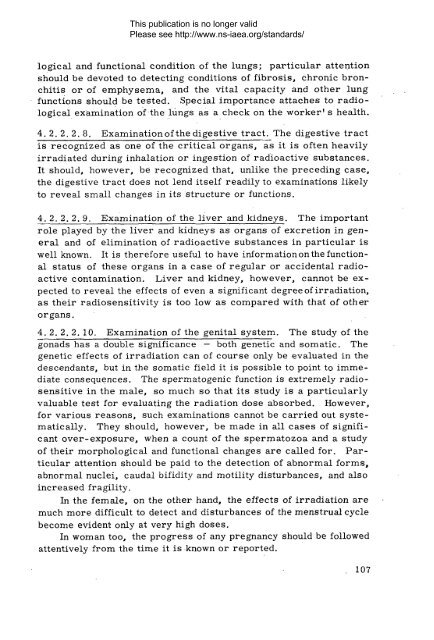Safety_Series_025_1968 - gnssn - International Atomic Energy ...
Safety_Series_025_1968 - gnssn - International Atomic Energy ...
Safety_Series_025_1968 - gnssn - International Atomic Energy ...
Create successful ePaper yourself
Turn your PDF publications into a flip-book with our unique Google optimized e-Paper software.
This publication is no longer validPlease see http://www.ns-iaea.org/standards/logical and functional condition of the lungs; particular attentionshould be devoted to detecting conditions of fibrosis, chronic bronchitisor of emphysema, and the vital capacity and other lungfunctions should be tested. Special importance attaches to radiologicalexamination of the lungs as a check on the w orker's health.4. 2. 2. 2. 8. Examination of ^the digestive tract. The digestive tractis recognized as one of the critical organs, as it is often heavilyirradiated during inhalation or ingestion of radioactive substances.It should, however, be recognized that, unlike the preceding case,the digestive tract does not lend itself readily to examinations likelyto reveal small changes in its structure or functions.4. 2. 2. 2. 9. Examination of the liver and kidneys. The importantrole played by the liver and kidneys as organs of excretion in generaland of elimination of radioactive substances in particular iswell known. It is therefore useful to have information on the functionalstatus of these organs in a case of regular or accidental radioactivecontamination. Liver and kidney, however, cannot be expectedto reveal the effects of even a significant degree of irradiation,as their radiosensitivity is too low as compared with that of otherorgans.4. 2. 2. 2. 10. Examination of the genital system. The study of thegonads has a double significance — both genetic and somatic. Thegenetic effects of irradiation can of course only be evaluated in thedescendants, but in the somatic field it is possible to point to immediateconsequences. The spermatogenic function is extremely radiosensitivein the male, so much so that its study is a particularlyvaluable test for evaluating the radiation dose absorbed. However,for various reasons, such examinations cannot be carried out systematically.They should, however, be made in all cases of significantover-exposure, when a count of the spermatozoa and a studyof their morphological and functional changes are called for. Particularattention should be paid to the detection of abnormal forms,abnormal nuclei, caudal bifidity and motility disturbances, and alsoincreased fragility.In the female, on the other hand, the effects of irradiation aremuch more difficult to detect and disturbances of the menstrual cyclebecome evident only at very high doses.In woman too, the progress of any pregnancy should be followedattentively from the time it is known or reported.1 07
















